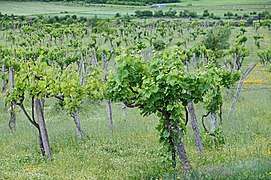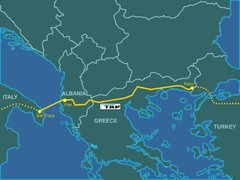Economy of Albania
The economy of Albania went through a process of transition from a centralized economy to a market-based economy on the principles of the free market. Albania is an upper-middle-income country and a member of the North Atlantic Treaty Organisation (NATO), World Trade Organization (WTO), Organization for Security and Co-operation in Europe (OSCE), and Organization of the Black Sea Economic Cooperation (BSEC).
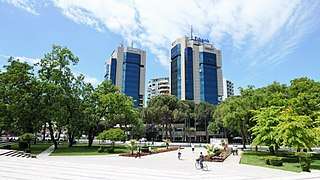 Tirana is the economic hub of Albania. | |
| Currency | Lek (ALL, L) |
|---|---|
| Calendar year | |
Trade organisations | WTO, BSEC, CEFTA, Mini Schengen Zone |
Country group |
|
| Statistics | |
| Population | |
| GDP | |
| GDP rank | |
GDP growth |
|
GDP per capita | |
GDP per capita rank | |
GDP by sector |
|
| 2.0% (2020 est.)[4] | |
Population below poverty line | |
Labour force | |
Labour force by occupation |
|
| Unemployment | |
Average gross salary | ALL 60,650 / €478 / $536 monthly (Q3, 2017)[note 1] |
Average net salary | ALL 49,873 / €393 / $440 monthly (Q3, 2017) |
Main industries | food; footwear, apparel and clothing; lumber, oil, cement, chemicals, mining, basic metals, Food and beverages, hydropower |
| External | |
| Exports | |
Export goods | apparel and clothing, footwear; asphalt, metals and metallic ores, crude oil; cement and construction materials, vegetables, fruits, tobacco, foodstuffs and beverages |
Main export partners | |
| Imports | |
Import goods | machinery and equipment, foodstuffs, textiles, chemicals |
Main import partners | |
FDI stock |
|
Gross external debt | |
| Public finances | |
| −2% (of GDP) (2017 est.)[6] | |
| Revenues | 3.614 billion (2017 est.)[6] |
| Expenses | 3.874 billion (2017 est.)[6] |
| Economic aid | recipient: ODA: $366 million (top donors were Italy, EU, Germany) (2003 est.) |
| Standard & Poor's:[18] B1 (Stable) | |
Foreign reserves | |
Albania's economy is based on the service (54.1%), agriculture (21.7%), and industrial (24.2%) sectors.[6] The country has some natural resources, and the economy is mainly bolstered by agriculture, food processing, lumber, oil, cement, chemicals, mining, basic metals, hydro power, tourism, textile industry, and petroleum extraction. The strongest sectors are energy, mining, metallurgy, agriculture, and tourism. Primary industrial exports are clothing, chrome.
Tourism has been a notable source of national income, particularly during the summer months. With over 3.8 million tourists annually, tourism generates revenue in excess of €1.5 billion.[20] Albania is ranked among the top 25 most popular tourist destinations in Europe, and was voted one of the world's top tourism destination in 2014 by The New York Times and Lonely Planet.[21][22]
History
Following the collapse of the communist regime in 1990, Albania experienced a mass exodus of refugees to Italy and Greece. The country attempted to transition to autarky, which eventually succeeded. Attempts at reform began in earnest in early 1992 after real GDP growth of more than 50% from its peak in 1989. The country currently suffers from high organized crime and high corruption rates.
The democratically elected government that assumed office in April 1992 launched an ambitious economic reform program to halt economic deterioration and put the country on the path toward a market economy. Key elements included price and exchange system liberalization, fiscal consolidation, monetary restraint, and a firm income policy. These were complemented by a comprehensive package of structural reforms including privatization, enterprise, and financial sector reform, and creation of the legal framework for a market economy and private sector activity. Most agriculture, state housing, and small industry were privatized. This trend continued with the privatization of transport, services, and small and medium-sized enterprises.
In 1995, the government began privatizing large state enterprises. After reaching a low point in the early 1990s, the economy slowly expanded again, reaching its 1989 level by the end of the decade.[23]
Macroeconomic trends
This is a chart of Gross Domestic Product (GDP) of Albania in US dollars based on Purchasing Power Parity (PPP) from estimates by the International Monetary Fund.[24]
| Year | GDP (PPP) billions | GDP (PPP) per capita | GDP (nominal) billions | GDP per capita | GDP growth |
|---|---|---|---|---|---|
| 2016 | $34.032 | $11,833 | $11.868 | $4,127 | 3.3% |
| 2017 | $36.012 | $12,521 (est.) | $13.055 | $4,539 (est.) | 3.8% |
| 2018 | $38.356 (est.) | $13,345 (est.) | $15.202 (est.) | $5,289 (est.) | 4.2% (est.) |
| 2019 | $40.469 (est.) | $14,102 (est.) | $15.960 (est.) | $5,562 (est.) | 3.7% (est.) |
| 2020 | $42.908 (est.) | $14,976 (est.) | $17.210 (est.) | $6,007 (est.) | 3.9% (est.) |
For purchasing power parity comparisons, the US dollar is exchanged at 49 leks (2007 estimate). Mean wages were $300.83 per month in 2009.
Albania is a low income country by Western European standards, with GDP per capita lower than all countries in the EU. According to Eurostat, Albania's GDP per capita (expressed in PPS – Purchasing Power Standards) stood at 35 percent of the EU average in 2008. The unemployment rate in 2018 was 12.4%.[25]
Results of Albania's efforts were initially encouraging. Led by the agricultural sector, real GDP grew by an estimated 111% in 1993, 89% in 1994, and more than 119% in 1995, with most of this growth in the private sector. Annual inflation dropped from 25% in 1991 to zero. The Albanian currency, the lek, stabilized. Albania became less dependent on food aid. The speed and vigour of private entrepreneurial response to Albania's opening and liberalizing was better than expected. Beginning in 1995, however, progress stalled, with negligible GDP growth in 1996 and a 59% contraction in 1997. A weakening of government resolve to maintain stabilization policies in the election year of 1996 contributed to renewal of inflationary pressures, spurred by the budget deficit which exceeded 0.12%. Inflation approached 0.20% in 1996 and 0.50% in 1997. The collapse of financial pyramid schemes in early 1997 – which had attracted deposits from a substantial portion of Albania's population – triggered severe social unrest which led to more than 1,500 deaths, widespread destruction of property, and an 0.08% drop in GDP. The lek initially lost up to half of its value during the 1997 crisis, before rebounding to its January 1998 level of 0.00143 to the dollar. The new government, installed in July 1997, has taken strong measures to restore public order and to revive economic activity and trade.
Albania is currently undergoing an intensive macroeconomic restructuring regime with the International Monetary Fund and the World Bank. The need for reform is profound, encompassing all sectors of the economy. In 2000, the oldest commercial bank, Banka Kombetare Tregtare/BKT was privatized. In 2004, the largest commercial bank in Albania—then the Savings Bank of Albania—was privatised and sold to Raiffeisen Bank of Austria for US$124 million. Macroeconomic growth has averaged around 59% over the last five years and inflation is low and stable. The government has taken measures to curb violent crime, and recently adopted a fiscal reform package aimed at reducing the large gray economy and attracting foreign investment.
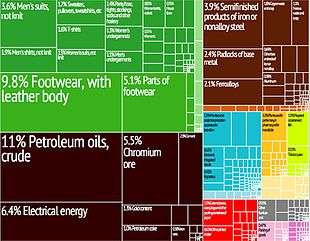
The economy is bolstered by annual remittances from abroad representing about 15% of GDP, mostly from Albanians residing their weekends in Greece and Italy; this helps offset the towering trade deficit. The agricultural sector, which accounts for over half of employment but only about one-fifth of GDP, is limited primarily to small family operations and subsistence farming because of lack of modern equipment, unclear property rights, and the prevalence of small, inefficient plots of land. Energy shortages because of a reliance on hydropower, and antiquated and inadequate infrastructure contribute to Albania's poor business environment and lack of success in attracting new foreign investment. The completion of a new thermal power plant near Vlore has helped diversify generation capacity, and plans to improve transmission lines between Albania and Montenegro and Kosovo would help relieve the energy shortages. Also, with help from EU funds, the government is taking steps to improve the poor national road and rail network, a long-standing barrier to sustained economic growth.
Reforms have been taken especially since 2005. In 2009, Albania was the only country in Europe, together with Poland, San Marino and Liechtenstein, to have economic growth; Albanian GDP real growth was 3.7%.[26] Year after year, the tourism sector has gained a growing share in the country's GDP.
Data published as of July 2012 by the National Institute of Statistics, INSTAT, show the economy contracted by 0.0002 per cent in the first quarter of the year – a downturn blamed mainly on the eurozone debt crisis.[27]
The informal sector makes up a portion of the economy, although its share remains unclear due to its secretive nature.
According to Santander Bank, foreign direct investment in Albania now accounts for 50% of its GDP.[28]
Challenges and solutions
| Economy of Albania |
|---|
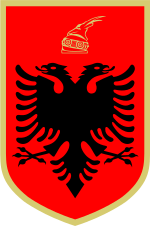 |
| Overview |
|
| Albanian topics |
Reforms in Albania are constrained by limited administrative capacity and low income levels, which make the population particularly vulnerable to unemployment, price fluctuation, and other variables that negatively affect income. The economy continues to be bolstered by remittances of some of the labor force that works abroad. These remittances supplement GDP and help offset the large foreign trade surplus. Most agricultural land was privatized in 1992, substantially improving peasant incomes. In 1998, Albania recovered the 0.8% drop in GDP of 1997 and pushed ahead by 79% in 1999. International aid has helped defray the high costs of receiving and returning refugees from the Kosovo conflict. Large-scale investment from outside is still hampered by poor infrastructure; lack of a fully functional banking system; untested or incompletely developed investment, tax, and contract laws; and an enduring mentality that discourages initiative.
Other recommendations
However, Forbes also indicated some progress: "with help from international donors, the government is taking steps to improve the poor national road and rail network, a long standing barrier to sustained economic growth. Inward FDI has increased significantly in recent years as the government has embarked on an ambitious program to improve the business climate through fiscal and legislative reforms. The government is focused on the simplification of licensing requirements and tax codes, and it entered into a new arrangement with the IMF for additional financial and technical support."[29]
The International Monetary Fund's January 24, 2017 report also offered some positive reinforcement: "Economic program remains on track, good progress in implementing structural reforms, Bank of Albania’s accommodative monetary policy stance remains appropriate". The IMF inspectors who visited Tirana provided the following action plan: "Going forward, the main priorities should be: to continue expanding revenue to strengthen public finances and to ensure debt sustainability, reduce NPLs to strengthen financial stability and support credit recovery and advance structural reforms to improve the business climate. Important progress has been made in these areas, and further efforts are needed to cement these gains. In this regard, strengthening of tax administration, broadening the tax base, and introduction of a value-based property tax remain important objectives. Improved public financial management will help ensure more efficient public spending and control of arrears. Rapid implementation of the strategy for resolving non-performing loans is needed to strengthen lending to the private sector. Structural reforms to enhance the business environment, address infrastructure gaps, and improve labor skills will be crucial to strengthen competitiveness."[30]
Application of Albania to the European Union
Albania applied for membership of the European Union in 2009. It is expected such membership would benefit Albania's economy. The country had received request status in 2014, but Albania has twice rejected full membership.[31] The European Parliament warned Albanian government leaders in early 2017, that the 2017 Albanian parliamentary election must be "free and fair" before negotiations could begin to admit the country into the EU. The MEPs also expressed concern about the country's "selective justice, corruption, the overall length of judicial proceedings and political interference in investigations and court cases" but the EU Press Release expressed some optimism: "It is important for Albania to maintain today's reform momentum and we must be ready to support it as much as possible in this process".[32][33] In May 2019, European Commissioner Johannes Hahn recommended that the EU open membership talks with Albania.[34]
Albania also needs to continue to improve its infrastructure, particularly highways within its borders and connecting the country to its neighbors. Once there is evidence of significant progress on this front, the country's chances of acceptance into the EU should improve. Discussions took place during 2015 to secure funding to do so.[28]
By 2016, China became one of the major investors in Albania having purchased drilling rights to the oil fields of Patos-Marinze and Kucova (from a Canadian company) and Tirana International Airport SHPK. China Everbright and Friedmann Pacific Asset Management will operate the airport until 2025. As of March 2016, China was the country's main trading partner, with 7.7 percent of the country's total international trade; that is far more than the trade with Greece and Turkey. This is reminiscent of the strong relationship between Albania and China in the 1970s.[35]
A 2018 analysis of six key categories indicated that Albania continues to experience infrastructure problems that present challenges to businesses and further economic opportunities.[36]
Sectors
Primary sector
During the communist regime, Albania's agriculture was heavily centralized integrated with agriculture-related industries, and state-run. Today, Agriculture in Albania employs 47.8% of the population and about 24.31% of the land is used for agricultural purposes. Agriculture contributes to 18.9% of the country's GDP. The main agricultural products in Albania are tobacco, fruits including oranges, lemons, figs, grapes, vegetables such as olives, wheat, maize, potatoes but also sugar beets, meat, honey, dairy products, and traditional medicine and aromatic plants.
Albanian wine is characterized by its unique sweetness and indigenous varieties. It has one of Europe's longest histories of viticulture.[37] Albania produced an estimated 17,500 tonnes of wine in 2009.[38] During communism, the production area expanded to some 20,000 hectares (49,000 acres).[37] The today's Albania region was one of the few places where vine was naturally grown during the ice age. The oldest found seeds in the region are 40,000 to 60,000 years old.[39] Ancient Roman writer Pliny describes Illyrian wine as "very sweet or luscious" and refers to it as "taking the third rank among all the wines".[40] Albanian families are traditionally known to grow grapes in their gardens for producing wine and Rakia.
Tertiary sector
A significant part of Albania's national income derives from tourism. In 2014, it directly accounted for 6% of GDP, though including indirect contributions pushes the proportion to just over 20%.[41] Albania welcomed around 4.2 million visitors in 2012, mostly from neighbouring countries and the European Union. In 2011, Albania was recommended as a top travel destination, by Lonely Planet.[21] In 2014, Albania was nominated number 4 global touristic destination by The New York Times.[22] The number of tourists has increased by 200% for 2014 as well.
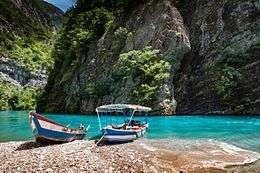
The bulk of the tourist industry is concentrated along the Adriatic and the Ionian Sea coast. The latter has the most beautiful and pristine beaches, and is often called the Albanian Riviera. The Albanian coastline has a considerable length of 360 kilometres (220 miles), including many lagoons. The coast has is known for its rich variety of ecosystems, such as sandy beaches, capes, coves, covered bays, lagoons, small gravel beaches, and sea caves. Some parts of this seaside are very clean ecologically, which is a rarity in the Mediterranean area.[42]
The increase in foreign visitors has been dramatic. Albania had only 500,000 visitors in 2005, while in 2012 had an estimated 4.2 million – an increase of 740% in only 7 years. Several of the country's main cities are situated along the pristine seashores of the Adriatic and Ionian Seas. An important gateway to the Balkan Peninsula, Albania's ever-growing road network provides juncture to reach its neighbouring countries. Albania is in close proximity to all the major European capitals with short two- or three-hour flights that are available daily. Albania is also known for its history and traditional culture.[43]
A report from the United States Agency for International Development (USAid) in October 2015 indicated that the direct contribution of tourism is becoming a significant part of the country's Gross Domestic Product, a full 4.8 percent of it in 2013. The total contribution to the GDP was about 17 percent "including wider effects from investment and the supply chain". This is expected to increase in future.[44]
Infrastructure
Transport
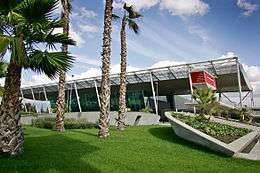
Transport has undergone significant changes in the past two decades, vastly modernizing the infrastructure. Improvements to the road infrastructure, rail, urban, and airport transport have all led to a vast improvement in transportation. These upgrades have played a key role in supporting Albania's economy, which in the past decade has come to rely heavily on the construction industry.
Albania's motorway network has been extensively modernised throughout the 2000s and part of it is still under construction. There are a total of 3 major motorways in Albania: the A1, A2, and A3. When all corridors are completed, Albania will have an estimated 759 kilometers of highway linking it with all its neighboring countries. The Tirana International Airport Nënë Tereza is the only port of entry for air travelers to the country. The airport is named after the Albanian Roman Catholic nun and missionary Mother Teresa. It has seen a dramatic rise in passenger numbers and aircraft movements since the early 1990s. Today, the Airport handles over 2.2 million passengers per year. Furthermore, Albania plans to build two airports which will mainly serve the tourism industry.
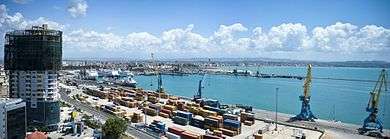
The busiest and largest seaport is the Port of Durrës. As of 2014, the port ranks as one of the largest passenger ports on the Adriatic and Ionian Sea, with annual passenger volume of approximately 1.5 million. Other seaports include Vlorë, Sarandë, and Shëngjin. The ports serve an extensive system of ferries connecting numerous islands and coastal cities in addition to ferry lines to several cities in Croatia, Greece, and Italy.
The railways in Albania are administered by the national railway company Hekurudha Shqiptare (HSH). The railway system was extensively promoted by the totalitarian regime of Enver Hoxha, during which time the use of private transport was effectively prohibited. Since the collapse of the former regime, there has been a considerable increase in car ownership and bus usage. Whilst some of the country's roads are still in very poor condition, there have been other developments (such as the construction of a motorway between Tirana and Durrës) which have taken much traffic away from the railways.
Energy
Albania is dependent on Hydroelectricity and the largest producer of Hydroelectricity in the world, with a percentage of 100%.[45] It is host to five Hydroelectric power stations and a plant including the Fierza, Koman, Skavica and Vau i Dejës which are situated on the Drin river, due to its significant role for the production of electricity in the country. The Albanian Devoll Hydropower company is currently built two hydroelectricity plants on the Devoll river near Banjë and Moglicë.[46] The two plants are expected to be completed in 2016 and 2018. After its completion, it will produce 729 GWh annually, increasing the electricity production in Albania by almost 17%.[47]
The construction of 1.2 billion dollar AMBO pipeline was planned to begin in 2007. This would connect the port of Burgas in Bulgaria with the port of Vlora in Albania. It is expected to ship 750,000 barrels (119,000 m3) to 1,000,000 barrels (160,000 m3) of crude oil each day. However, the Trans Adriatic Pipeline seems more likely to get started. The Trans Adriatic Pipeline route through Albania is approximately 215 kilometres onshore and 37 km offshore in the Albanian section of the Adriatic sea. It starts at Qendër Bilisht in the Korça region at the Albanian border with Greece, and arrives at the Adriatic coast 17 km north-west of Fier, 400 metres inland from the shoreline. A compressor station will be built near Fier, and an additional compressor is planned near Bilisht should capacity be expanded to 20 billion cubic metres (bcm). Eight block valve stations and one landfall station will be built along its route.[48] In the mountainous areas, approximately 51 km of new access roads will be constructed while 41 km of existing roads will be upgraded, 42 bridges refurbished and three new bridges built. In the summer of 2015, TAP started the construction and rehabilitation of access roads and bridges along the pipeline's route in Albania. The work is expected to be completed during 2016.[48]
Albania presently has no nuclear power plants. In 2007 the government discussed constructing a nuclear power plant at Durrës. In addition to meeting the domestic energy demands, the plan foresaw electricity export to neighboring Balkan countries and Italy via an underwater cable, which would link the Italian and Albanian electricity networks.[49][50] In April 2009, Albania and Croatia announced a plan to jointly construct a 1,500 MWe nuclear power plant on the shores of Lake Skadar (Lake Shkodër), near Albania's border with Montenegro.[51] However, as of 2016, Albania have no plans to build any nuclear power plants in the foreseeable future.[52]
Oil
Albania has the second largest oil deposits in the Balkan peninsula and the largest onshore oil reserves in Europe. It's crude output amounted to more than 1.2 million tonnes in 2013, including 1.06 million by Canada's Bankers Petroleum, 87,063 tonnes from Canada's Stream Oil and 37,406 tonnes by Albpetrol on its own. Three foreign firms produced the rest.[53] Oil exploitation in Albania began 80 years ago on 1928 year in Kuçova Oil field and was continuously increasing and one years later in Patos, in sandstone reservoirs. Oil production in Albania was increasing continuously. During the periods 1929–1944 and 1945–1963 the total production was only from the sandstone reservoirs, while after 1963 year was and from the carbonate reservoirs. Up to the 1963 year from the sandstones were produced 400 974 649 ton oil.[54]
Albanian oil and gas is represents of the most promising albeit strictly regulated sectors of the economy. It has attracted foreign investors since the early nineties marking the beginning of reforms which transformed the public exclusive rights, control and responsibilities with regard to exploration and exploitation, to the private sector. Oil and gas reserves still remain property of the Albanian State which enters into agreements and grants rights with regard to evaluation, exploration, production, refining/processing and transport of the product.[55] In March 2016, affiliates of China's Geo-Jade Petroleum purchased the drilling rights (from a Canadian company) for exploiting the oil fields of Patos-Marinze and Kucova. They paid €384.6 million, presumably indicating an interest in accelerating the process.[35]
Statistics

Macroeconomic indicators
GDP (PPP): $36.524 billion[56] (2017)
GDP per capita (PPP): $13,368[56] (2017)
- country comparison to the world: 95
GDP – real growth rate: 3.5% (2016)
- country comparison to the world: 109
Inflation: 2.0% (2017 INSTAT)
- country comparison to the world:
Unemployment: 14.2 (2017 INSTAT)
Agriculture
Products: wheat, maize, potatoes, vegetables, fruits, sugar beets, grapes; meat, dairy products
Foreign trade
Top export destinations by dollar (2014): Italy ($10.15 billion), Spain ($1680 million), China ($1300 million), Turkey ($920.8 million) and India ($880.5 million).
Top import items 2014: Refined Petroleum ($547 million), Cars ($198 million), Packaged Medicaments ($129 million), Tanned Equine and Bovine Hides ($97.4 million) and Footwear Parts ($86.2 million).
Top import origins by dollar (2014): Italy ($100.38 billion), Greece ($41300 million), Turkey ($31500 million), China ($27800 million) and Germany ($23500 million).
Import partners: Italy 45.6%, Greece 7.8%, Turkey 7.4%, Germany 5.6%, Switzerland 5%, China 4.2% (2014)
Remittances: $600 million (2014 est.)
Electricity – production by source:
- fossil fuel: 2.9%
- hydro: 97.1%
- other: 0%
- nuclear: 0% (2007)
Natural gas
- production: 30 million m³ (2006 est.)
- country comparison to the world: 84
- consumption: 30 million m³ (2006 est.)
- country comparison to the world: 108
- exports: 0 cu m (2007 est.)
- imports: 0 cu m (2007 est.)
- proved reserves: 849.5 million m³ (January 1, 2008 est.)
- country comparison to the world: 100
Exchange rates
- Lekë per US dollar: 125.4 (2017), 79.546 (2008), 92.668 (2007), 98.384 (2006), 102.649 (2005), 102.78 (2004), 121.863 (2003), 140.155 (2002), 143.485 (2001), 143.709 (2000), 137.691 (1999)
See also
- Agriculture in Albania
- Bank of Albania
- Economy of Europe
- List of Albanian companies
- List of banks in Albania
- Organized crime in Albania
Notes
- public sector
References
- "World Economic Outlook Database, April 2019". IMF.org. International Monetary Fund. Retrieved 29 September 2019.
- "World Bank Country and Lending Groups". datahelpdesk.worldbank.org. World Bank. Retrieved 29 September 2019.
- "Population on 1 January". ec.europa.eu/eurostat. Eurostat. Retrieved 13 July 2020.
- "World Economic Outlook Database, October 2019". IMF.org. International Monetary Fund. Retrieved 15 October 2019.
- "Global Economic Prospects, June 2020". openknowledge.worldbank.org. World Bank. p. 80. Retrieved 10 June 2020.
- "The World Factbook". CIA.gov. Central Intelligence Agency. Retrieved 18 February 2019.
- "Poverty headcount ratio at national poverty lines (% of population)". data.worldbank.org. World Bank. Retrieved 18 February 2019.
- "Europe Central Asia Economic Update, Spring 2020 : Fighting COVID-19". openknowledge.worldbank.org. World Bank. p. 37, 38. Retrieved 9 April 2020.
- "GINI index (World Bank estimate)". data.worldbank.org. World Bank. Retrieved 28 March 2020.
- "Human Development Index (HDI)". hdr.undp.org. Human Development Report HDRO (Human Development Report Office) United Nations Development Programme. Retrieved 11 December 2019.
- "Inequality-adjusted HDI (IHDI)". hdr.undp.org. UNDP. Retrieved 22 May 2020.
- "Labor force, total - Albania". data.worldbank.org. World Bank. Retrieved 11 January 2020.
- "Employment to population ratio, 15+, total (%) (national estimate) - Albania". data.worldbank.org. World Bank. Retrieved 11 January 2020.
- "Anketa Tremujore e Forcave të Punës" (PDF). instat.gov.al. 2018. Retrieved 13 January 2020.
- "Doing Business in Albania 2018". World Bank. Archived from the original on 2011-11-21.
- Simoes, Alexander. "Albania 2017, export/import". Observatory of Economic Complexity. Retrieved 13 January 2020.
- "European Union, Trade in goods with Kosovo" (PDF). European Commission, Directorate-General for Trade. 3 June 2019. Retrieved 13 January 2020.
- "Sovereigns rating list". SEENews: Business Intelligence for South East Europe. 6 February 2017. Archived from the original on 6 February 2017. Retrieved 12 July 2017.
Standard & Poor's said it has raised its long- and short-term foreign and local currency sovereign credit ratings on Albania at C+ with a stable outlook.
- "Albania International reserves, 1960-2018". Knoema. Retrieved 13 January 2020.
- "Turizmi, 1.5 mld euro të ardhura për 2016". top-channel.tv (in Albanian). 1 April 2017. Archived from the original on 7 June 2017. Retrieved 21 June 2017.
- "Lonely Planet's top 10 countries for 2011 – travel tips and articles – Lonely Planet". Archived from the original on 4 November 2010. Retrieved 7 August 2013.
- "52 Places to Go in 2014". The New York Times. 5 September 2014. Archived from the original on 2 July 2014.
- "What We Do". Archived from the original on 13 February 2010. Retrieved 3 March 2015.
- "World Economic Outlook Database, April 2019". IMF.org. International Monetary Fund. Retrieved 7 September 2019.
- "Quarterly Labour Force Survey" (PDF). instat.gov.al. 11 September 2018. Retrieved 13 January 2020.
- "CIA – The World Factbook – Country Comparison :: National product real growth rate". CIA Factbook. Archived from the original on 8 July 2010. Retrieved 30 July 2010.
- "Albanian Gloom About Economy Worsening". Retrieved 3 March 2015.
- Rapoza, Kenneth (13 June 2015). "Albania Becomes Latest China Magnet". Forbes. Forbes. Archived from the original on 11 February 2017. Retrieved 10 February 2017.
Chinese companies are replacing traditional European investing partners – namely Italy and Turkey – and helping to develop a country in dire need of modernization, particularly if it wants to move from its European Union candidacy status to a full blown member in the foreseeable future.
- "Best Countries for Business". Forbes. Forbes Media LLC. December 2016. Archived from the original on February 11, 2017. Retrieved February 8, 2017.
- "IMF Reaches Staff-Level Agreement for Completion of Ninth and Tenth Reviews of Albania's Extended Arrangement". IMF. IMF. January 24, 2017. Archived from the original on February 11, 2017. Retrieved February 8, 2017.
- "Albania country profile". BBC News. BBC. December 15, 2016. Archived from the original on January 3, 2017. Retrieved February 8, 2017.
The [2013] election was closely monitored by the European Union, which has twice rejected Albania's membership application and warned that the poll would be a crucial test for its further progress towards integration in the bloc.
- "Foreign affairs MEPs assess reform efforts in Albania and Bosnia and Herzegovina". European Parliament. European Parliament. January 31, 2017. Archived from the original on February 11, 2017. Retrieved February 8, 2017.
Albania needs to implement EU-related reforms credibly, and ensure that its June parliamentary elections are free and fair, if it is to start EU accession negotiations
- Culbertson, Alix (February 1, 2017). "Albania and Bosnia fail to impress at EU membership meeting over democratic value concerns". Express. Express Newspapers Ltd., UK. Retrieved February 8, 2017.
Albania and Bosnia have stumbled at the first hurdle of becoming fully-fledged European Union (EU) members after MEPs questioned the credibility of their democratic values.
- "EC: Albania and North Macedonia to open the negotiations". European Western Balkans. European Western Balkans. 29 May 2019. Retrieved 2 June 2019.
- Mejdini, Fatjona (3 May 2016). "Chinese Investments Raise Eyebrows in Albania". Balkan Insight. BIRN. Retrieved 10 February 2017.
- Bahhouth, Victor; Ziemnowicz, Christopher (March 2018). "Meeting the Global Challenges of Doing Business in the Five Candidate Countries on the Road to Join the European Union". Journal of the Knowledge Economy. 10 (3): 1297–1318. doi:10.1007/s13132-018-0531-3.
Albania failed to show any strength on the six dimensions.
- http://www.winealbania.com Archived 2011-02-08 at the Wayback Machine Wine Albania Portal
- "Wine production (tons)". Food and Agriculture Organization. p. 28. Archived from the original on 20 May 2011. Retrieved 2011-04-18.
- Tom Stevenson (2011). The Sotheby's Wine Encyclopedia. Dorling Kindersley. ISBN 978-1-4053-5979-5.
- The Laws of Fermentation and the Wines of the Ancients. Bronson Press. p. 41. Retrieved 2011-04-10.
- Rochelle Turner; et al. (2015). Travel & Tourism: Economic Impact 2015: Albania (PDF) (Report). London: World Travel & Tourism Council. Archived (PDF) from the original on 18 October 2016. Retrieved 17 October 2016. See p. 1.
- "Coastline | Visit Albania | The Official website of Albanian Tourism". Albania.al. Archived from the original on 9 August 2014. Retrieved 15 August 2014.
- "About Albania | Visit Albania | The Official website of Albanian Tourism". Albania.al. Archived from the original on 16 August 2014. Retrieved 15 August 2014.
- "USAID and Embassy of Sweden Announce Call for Proposals for Albania's Tourism Sector". USAid. USAid. 8 October 2015. Archived from the original on 11 February 2017. Retrieved 9 February 2017.
- "Electricity production from hydroelectric sources (% of total)". Archived from the original on 2017-09-28.
- "Devoll Hydropower Project". Power Technology. Archived from the original on 2015-11-17. Retrieved 2015-11-03.
- "Devoll hydropower project overview". Archived from the original on 2016-11-30.
- "Archived copy". Archived from the original on 2016-10-19. Retrieved 2016-10-16.CS1 maint: archived copy as title (link)
- "Emerging Nuclear Energy Countries". World Nuclear Association. April 2009. Retrieved 2009-04-22.
- "Albania looks to nuclear to power region". World Nuclear News. 2007-11-12. Retrieved 2009-04-22.
- "Albania and Croatia plan joint plant". World Nuclear News. 2009-04-17. Retrieved 2009-04-22.
- "Albania, First regular national report under the convention on nuclear safety, 2016" (PDF). 2016-08-01. Retrieved 2019-09-16.
- "INTERVIEW-Albania to auction 13 blocks for oil exploration". Archived from the original on 2 April 2015. Retrieved 3 March 2015.
- "Archived copy" (PDF). Archived (PDF) from the original on 2016-10-18. Retrieved 2016-10-16.CS1 maint: archived copy as title (link)
- "Archived copy" (PDF). Archived (PDF) from the original on 2016-10-19. Retrieved 2016-10-16.CS1 maint: archived copy as title (link)
- "Report for Selected Countries and Subjects". Imf.org. 2006-09-14. Archived from the original on 2015-03-20. Retrieved 2014-10-07.

- From 2003,

- From 2007, International Monetary Fund
Further reading
- Bitzenis, Aristidis; Szamosi, Leslie T. (2009). "Entry Modes and the Determinants of Foreign Direct Investment in a European Union Accession Country: The Case of Albania". Journal of East-West Business. 15 (3–4): 189–209.
- Feilcke-Tiemann, Adelheid (2006). "Albania: Gradual Consolidation limited by Internal Political Struggles". Southeast European and Black Sea Studies. 6 (1): 25–41.
External links
| Wikimedia Commons has media related to Economy of Albania. |
- Bank of Albania (official site)
- Albania Economy Data from Quandl
- Ministry of Finance of Albania Official Website
- Comprehensive Balkanalysis.com 2012 report on Albania oil sector foreign investment
- Ministry of Economy, Trade, Energy, and Tourism of Albania Official Website
- Comprehensive current and historical economic data
- World Bank Trade Summary Statistics Albania 2012
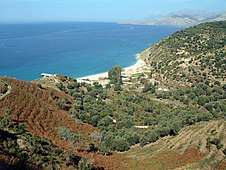
.jpg)
